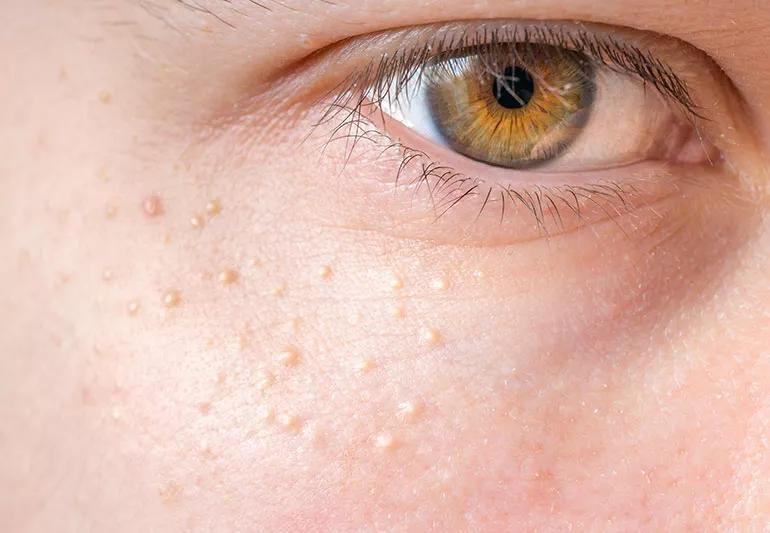Milia go away on their own in a few weeks

If you have tiny white bumps on your nose, chin or cheeks, resist the urge to try removing them.
Advertisement
Cleveland Clinic is a non-profit academic medical center. Advertising on our site helps support our mission. We do not endorse non-Cleveland Clinic products or services. Policy
You likely have milia, a skin condition that’s common among newborns — so common, in fact, that up to half of all babies develop milia.
Milium (that’s the single form of the word!) happen when dead skin cells get trapped beneath the skin’s surface and form small, hard cysts. Milia are common in babies because their skin is still learning to exfoliate, or slough off dead skin cells, on its own.
Although milia are most commonly seen on the nose, chin or cheeks, they can occur on other areas such as the upper trunk and limbs.
In adults, milia fall into two types: primary and secondary. Primary milia are similar to the kind that babies get. Secondary milia happen when a skin condition that leads to blistering damages the pore lining. Burns or severe rashes, for example, can increase the number of skin cells trapped under the skin’s surface.
Usually, the best treatment for milia is to do nothing, says dermatologist Melissa Piliang, MD. Milia usually disappears in a few weeks.
“If you’re an adult with milia, you might try an over-the-counter exfoliating treatment that contains salicylic acid, alpha hydroxyl acid or a retinoid such as adapalene,” Dr. Piliang says. “These can improve the skin’s natural turnover by removing the dead cells, and may help the bumps go away faster.”
Advertisement
For adults, sun damage can be a contributing factor to milia because it makes skin leathery. This makes it more difficult for dead cells to rise to the skin’s surface and shed normally.
Maintaining a good skin-care routine can help minimize the chance of milia appearing in adults, Dr. Piliang says.
“Because secondary milia can be caused by sun damage, wear a moisturizer or makeup with at least SPF 15 every day to protect your skin,” she says. “I recommend an SPF of 30 in the warmer months.”
If your baby is the one with milia, Dr. Piliang offers these tips:
It’s important that you refrain from trying to remove the bumps by squeezing or scraping them as you would a pimple.
“Milia are hard and beneath the skin’s surface, so you’ll likely only irritate and damage the skin around the cyst,” she says. “You could wind up scarring the skin permanently.”
If your milia don’t respond to an exfoliating treatment after several weeks, consider making an appointment with a dermatologist. The doctor may use a hypodermic needle to remove the cyst, or freeze the cyst and then remove it. Your doctor can also make sure that the milia aren’t something more serious.
If your baby’s complexion doesn’t clear up within three months, consult your baby’s doctor at your next well-baby visit.
Advertisement
Learn more about our editorial process.
Advertisement

Olive oil works as a skin moisturizer, but it’s not right for everyone

This important skin care ingredient helps protect your skin and keep it moisturized

Sunscreen, moisturizer and a topical antioxidant every day are a good start to a good skin care routine

Your skin care routine doesn’t need to be overly involved — or expensive

Most people should do it twice a day: once in the morning and once again at night

Start with a gentle cleanser, opt for lukewarm water and carefully pat your face dry

Your skin can be either dry, oily, normal, combination or sensitive — and knowing which kind you have can help you take care of it

Allantoin is a common ingredient in a host of skin care products and cosmetics that helps moisturize and smooth skin

If you’re feeling short of breath, sleep can be tough — propping yourself up or sleeping on your side may help

If you fear the unknown or find yourself needing reassurance often, you may identify with this attachment style

If you’re looking to boost your gut health, it’s better to get fiber from whole foods